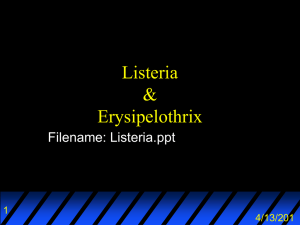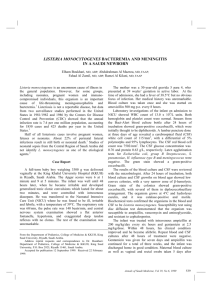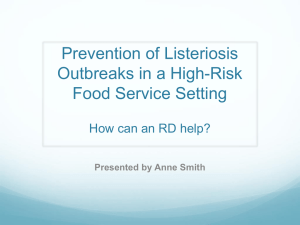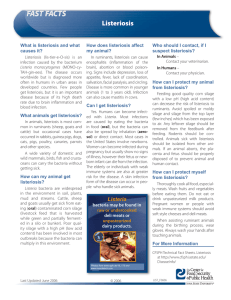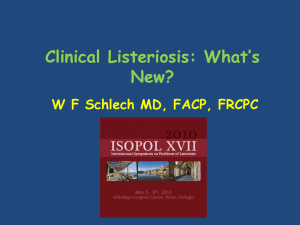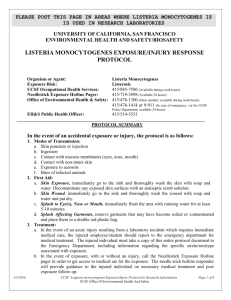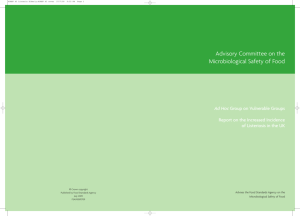Figure 4 - Group-P
advertisement
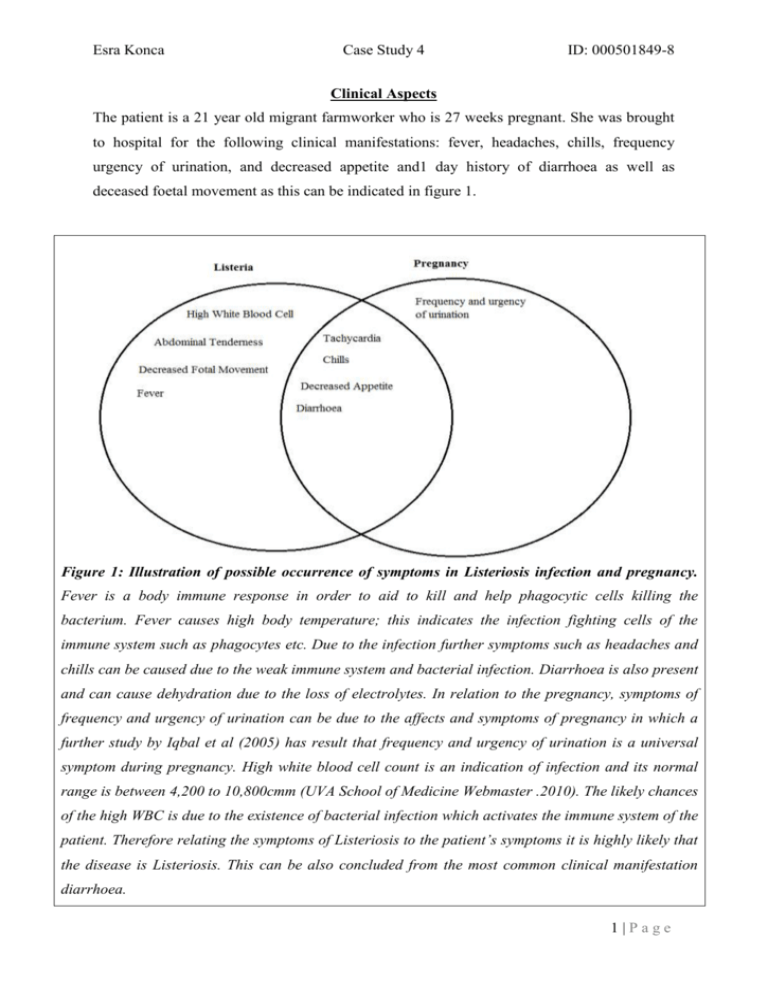
Esra Konca Case Study 4 ID: 000501849-8 Clinical Aspects The patient is a 21 year old migrant farmworker who is 27 weeks pregnant. She was brought to hospital for the following clinical manifestations: fever, headaches, chills, frequency urgency of urination, and decreased appetite and1 day history of diarrhoea as well as deceased foetal movement as this can be indicated in figure 1. Figure 1: Illustration of possible occurrence of symptoms in Listeriosis infection and pregnancy. Fever is a body immune response in order to aid to kill and help phagocytic cells killing the bacterium. Fever causes high body temperature; this indicates the infection fighting cells of the immune system such as phagocytes etc. Due to the infection further symptoms such as headaches and chills can be caused due to the weak immune system and bacterial infection. Diarrhoea is also present and can cause dehydration due to the loss of electrolytes. In relation to the pregnancy, symptoms of frequency and urgency of urination can be due to the affects and symptoms of pregnancy in which a further study by Iqbal et al (2005) has result that frequency and urgency of urination is a universal symptom during pregnancy. High white blood cell count is an indication of infection and its normal range is between 4,200 to 10,800cmm (UVA School of Medicine Webmaster .2010). The likely chances of the high WBC is due to the existence of bacterial infection which activates the immune system of the patient. Therefore relating the symptoms of Listeriosis to the patient’s symptoms it is highly likely that the disease is Listeriosis. This can be also concluded from the most common clinical manifestation diarrhoea. 1|Page Esra Konca Case Study 4 ID: 000501849-8 Accounting the life style of the patient as a migrant farmworker as well as the symptoms of the patient, it is likely that the cause of the stillbirth is due to the bacterial infection called Listeriosis. Listeriosis is caused by bacteria of the genus Listeria (mainly listeria monocytogenes) (Jewell et al.2003). Listeria monocytogenes belongs to a gram-positive foodborne bacterium and is a bacterial pathogen and is factitively intracellular foodborne pathogen which induces its own uptake into on-pathogen cells (Cresence et al .2007). The bacterium affects primarily pregnant women, neonates, elderly adults and immunocompromised individuals who subsequently have supressed immune system. The bacterium can precede more serious dilemmas of the disease such as meningitis, meningoencephalitis, Septicaemia and cervical infectious. Figure 3: Demonstration of Listeria monocytogenes using TEM. The appearance of listeria monocytogenes is described as rod shaped motile, non-sporeforming pathogenic bacterium and has aerobic and anaerobic characteristics. It is capable of growing at -18 oC to 10oC. REFERENCE 2|Page Esra Konca Case Study 4 ID: 000501849-8 A conclusive diagnostic test will rely upon the isolation of the L. monocytogenes. Clinically the organism can be isolated from blood, cerebrospinal fluid or placenta (CFSPH, 2012). However the human infection is commonly involved in the central nervous system. L. monocytogenes can be identified in tissues. Further diagnosis will depend on the confirmation of the isolation from CSF, blood, amniotic fluid, placenta, meconium, lochia and other infection locations (Alberta Health and Wellness, 2011). The colonies on the blood culture represent a narrow band of beta (β)-haemolysis resembling that of β-streptococci (Cresence et al .2007). The infection can be detected with range of methods based upon the biochemical tests as well as enzyme reactions (Alberta Health and Wellness, 2011). Acheson et al 2000 has stated that the clinical appearance and identification of the organism can be late recognised, especially in the absence of fever which can lead to late treatment. Listeriosis has become a common clinical syndrome identified in humans. The symptom will resemble gastrointestinal illness. Other diseases like listeria monocytogenes and salmonella campylobacter causes foodborne gastroenteritis. Listeriosis has 2 types of illnesses. Early-onset Listeriosis develops maternal sepsis and choriomnionitis. This type of Listeriosis causes abortion, stillbirth or premature delivery of severely affected infants which may cause “granulomatosis infantiseptica”. Recent studies show that only 20% of the infants are born alive, whereas the abortion and stillbirths rate increases by 150%. Late-onset Listeriosis usually features meningitis and occurs in infants. Pregnant women who have early-onset Listeriosis, usually suffers non-specific flu like symptoms which can be misdiagnosed as influenza or pyelonephritis. Early detection of Listeriosis in pregnant females using blood culture can be an opportunity to treat the infant (Schlech et al 1996). The main developments in rapid identification methods have been ruled to be immunological and nucleic acid-based detection systems. Such other developments have been made in other areas such as impedance and conductance, bacteriophages, biosensors, microscopy and miniaturized and automated biochemical detection kits (Foley et al .2006). 3|Page Esra Konca Case Study 4 ID: 000501849-8 Table 1: Table below demonstrates the variable methods and techniques used to identify the pathogen. Various techniques have been established and undertaken. These detection methods include the following, fluorescence, or chemiluminescence, impedance, immunochromatography and immunomagnetic separation taken from (Foley et al. 2006). Technique Explanation Immunological Immunological technique has been a major impact in the progression of food assay pathogens. One of the most common immunoassay in detection of food pathogen has been enzyme-linked immunsorbent assay (ELISA). PCR PCR method was used to detect pathogenic microorganisms and was a known as a nucleic-acid amplification technique. The technique was rapid, specific and sensitive in the analysis of food pathogens. The PCR process targets a specific region of nucleic acid and amplifies up to a billion fold. PCR process does not confirm the specific gene fragment. The specific DNA region is targeted through hybridization. PCR is a rapid, specific and sensitive method for detecting food pathogens. Nucleic acid This technique since the 1980’s had been the type of technology which technologies detects high levels of specificity due to the detection of specific nucleic-acid sequences. Furthermore to the methodology had been either developed or were being developed for the use of rapid methods i.e. amplification, microarrays and chips. Nucleic acid methodology was an attractive method Figure 4: Further diagnoses have been recently developed for fast, reliable and high specific detection of Listeria. Vermicon solution for microbiology have developed a VIT- Listeria kit which unequivocally detects Listeria monocytogenes and Listeria genera. Investigations provide the existence of the bacteria and whether the pathogen L. monocytogenes is amongst them (Vermicon Solution for microbiology- VIT ® gene probe technology). 4|Page Esra Konca Case Study 4 ID: 000501849-8 Conclusion In conclusion, referring to the symptoms and tests carried out, the basic symptoms can be caused indirectly from the bacterial infection Listeriosis which is present in the patient. Whereas the patient has been examined for Chlamydia trachomatis. Referring to the laboratory studies undertaken, a cervical specimen assayed for Chlamydia trachomatis using PCR was negative and cervical culture for Neisseria gonorrhoea was not preformed. I believe the symptoms have misled the physician who undertook a cervical specimen assay for Chlamydia trachomatis. Considering the patient’s job and background history I believe the physician should have given an assumption of Listeriosis rather than sexual related disease. Moreover studies have stated that some of Listeriosis cases are not diagnosed because the correct microbiological investigations are not preformed and foetal loss early in gestation is rarely microbiologically investigated and additionally can be mistake for streptococci or contaminants such as corynebacteria McLauchlin et al .1988). Two blood cultures were drawn, and the patient was begun on ampicillin-sulbactam and gentamicin. The next morning the patient complained of right costovertebral tenderness and abdominal pain. On ultrasound, there was no fetal movement, and intrauterine fetal demise was suspected. Labour was induced, and a stillborn infant was delivered vaginally. 5|Page Esra Konca Case Study 4 ID: 000501849-8 References Books: WEB site: Alberta Health and Wellness (2011). Listeriosis Available at http://www.health.alberta.ca/documents/Guidelines-Listeriosis-2011.pdf (Accessed on 3rd January 2012) Queen’s printer for Ontario, ministry of health and long term care (2011) Listeriosis Available at www.health.gov.on.ca/english/providers/pub/disease/listeroa/listeriosis_clinical_qa_0 1_20080902.pdf (Accessed on 30th October 2011) Hospitality Institute of Technology and Management (2011) Listeria monocytogenes Available at http://www.hi-tm.com/1908/SECTION-2-D-1908.pdf (Accessed on 30th October 2011) MediResource Inc (2011) Fever Available at: http://bodyandhealth.canada.com/channel_condition_info_details.asp?disease_id=158 &channel_id=1020&relation_id=10884 (Accessed on 10th October 2011) NetDoctor.co.uk. (2011) Diarrhoea Available at: http://www.netdoctor.co.uk/diseases/facts/diarrhoea.htm (Accessed on 13th October 2011) State Government of Victoria. (2010) Diarrhoea Available at: http://www.betterhealth.vic.gov.au/bhcv2/bhcarticles.nsf/pages/diarrhoea?open (Accessed on 13th October 2011) 6|Page Esra Konca Case Study 4 ID: 000501849-8 UVA School of Medicine Webmaster (2010). Hematology Lab Differentials Available at: http://www.med-ed.virginia.edu/pda/refcards/HemLab/index.htm (Accessed on 15th October 2011) WebMD LLC (2012). Listeria monocytogenes Available at http://emedicine.medscape.com/article/220684-overview (Accessed on 3rd January 2012). Vermicon Solution for microbiology (2012) Listeria monocytogenes Available at: http://www.vermicon.com/en/en/products/VIT-Listeria-44 (Accessed on 3rd January 2012) World Organisation for Animal Health (Oie) (2012). Listeria monocytogenes Available at: http://www.oie.int/fileadmin/Home/eng/Health_standards/tahm/2.09.07_LISTERIA_ MONO.pdf (Accessed on 3rd January 2012) Journals 1. Acheson, D. Schlech, W.F. (2000) Foodborne Listeriosis. Clinical Infectious Diseases (September), p. 770–775 2. Aziz, F. Dodi, S. Grigoriu, A. Penupolu, S. (2011) Listeria peritonitis; common presentation of an uncommon organism. Professional Med J (March), p. 163-166 3. Cresence, V.M. Dharsana, K.S. Lekshmi, M.U. Prasad, S.P. Ramaswamy, V. Rejitha, J.S. Vijila, H.M. (2007) Listeria- review of epidemiology and pathogenesis. J Microbiology Immunol Infect (January), p. 4 – 13 4. Donachie, W. Low, J.C. (1997) A Review of Listeria monocytogenes and Listeriosis.The I"eterinau.]ournal (153), p. 9-29 7|Page Esra Konca Case Study 4 ID: 000501849-8 5. Foley. S.L. Grant, K. (2006) Molecular Techniques of Detection and Discrimination of Foodborne Pathogens and Their Toxins. Molecular Techniques to Detect Pathogens. p. 485- 510 6. Iqbal, J. Jammul, A. Razzaq, N. Salick, A. Sheikh, S. Wazir, S. (2005) Frequency of urinary symptoms in pregnancy. Biomedica/Vol. 21 (June) 7. Jewell, K. McLauchlin, J. Mitchell, R.T. Smerdon, W.J. (2004) Listeria monocytogenes and listeriosis: a review of hazard characterisation for use in microbiological risk assessment of foods. International Journal of Food Microbiology 92 (May), p. 15– 33 8. Kuukankorpi, A. Miettinen, A. Pasternack, R. Pitkajarvi, T. Vuorinen, P. (1996). Detection of Chlamydia trachomatis Infections in Women by Amplicor PCR: Comparison of Diagnostic Performance with Urine and Cervical Specimens. Journal of clinical microbiology. (April), p. 995-998 9. Loomis, W.P. Starnbach, M.N. (2006) Chlamydia trachomatis Infection Alters the Development of Memory CD8_ T Cells. The Journal of Immunology. (June), p. 40214027 10. Schlech, W.F. (1996) Overview of Listeriosis. Food Control (Vol 7), p. 183- 186 8|Page
